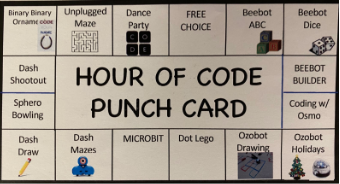
Coding Punch Cards

Overview
So you have robots...now what? How do you manage them? These coding punch cards can be customized and used to offer students activity choices while managing your learning environment.
Learning Objectives
Students will:
- Be able to use coding cards as a means to move through various coding lessons of the teacher’s choice.
Vocabulary
Vocabulary Words:
- Algorithm: An algorithm is a list of steps to finish a task.
- Program: A program is an algorithm that has been coded into something that can be run by a machine.
- Debugging: Debugging is finding the problem with the program or code and fixing it.
- Sequencing: Sequencing is putting steps in the correct order so computers can read the commands or Algorithm.
Pre-planning
To prepare for this lesson:
- This is a great tool to use for HOUR OF CODE IN DECEMBER. Students may have some familiarity with coding programs and robots. They may have used similar block coding in other activities. For these activities you can go as basic or as complex as you want to.
- Decide what activities you may want to use for your students based on availability. (Keep in mind you have access to various robots through your REMC or ISD.)
- You will create a punch card of activities for the students to rotate through.

- The idea is to have numerous stations and rotate students through every 15 minutes. Decide the length of time you want to run these activities. Ideally, you could run it one hour a day for a week, or it may be a “Day of Code”. Be as flexible as you like.
- There are many OZOBOT, CODE AND GO MOUSE, and DASH lessons in MiTechKids you could incorporate into this. Use the MiTechKids INDEX to search for lessons to incorporate.
- Review these two lessons:
- Binary Bracelet lesson can be found on code.org
- Unplugged Mazes can also be found on code.org
- This video gives an explanation of how to tape paths on the floor for Dash robots. These paths are a bit sophisticated. You may want to be a bit more simplistic for time constraints.
- Once you decide your lessons, MAKE A COPY of the code card and personalize it to your class.
- Print the cards on CARDSTOCK. Some teachers have downloaded the card into an LMS such as SEESAW.
- Have a stamp or a hole puncher ready to stamp or punch each station.
- You may want a timer to guide students through stations. Here is a timer you can project.
NOTE: If you have multiple Ozobot/Dash robots and want to have numerous stations, you will need one Dash for each station You will need one iPad or tablet for each station with Blockly for Dash downloaded to your iPad or tablet.
Accommodations
See Accommodations Page and Charts on the 21things4students.net site in the Teacher Resources.
Steps
Directions for this activity:
- The teacher will have the punch card ready for the students with various activities.
- Stations will be ready for the students with the different robots.
- The teacher says to students, ”Today you will become programmers. You will have a choice of activities today. You are the learner and you get to pick where you want to go."
- Instruct them as to how many activities you would like them to complete in the time allotted.
Assessment Options
Different options for assessing the students:
- Observations
- Check for understanding
- This is the link to the code choice card. Please make a copy to edit. This is also a great way to assess and keep track of work.
- You may also have students complete a reflection based on their activities.
MITECS COMPETENCIES & ISTE STANDARDS
MITECS: Michigan adopted the "ISTE Standards for Students" called MITECS (Michigan Integrated Technology Competencies for Students) in 2018.
Empowered Learner
1d. Students understand the fundamental concepts of technology operations, demonstrate the ability to choose, use and troubleshoot current technologies and are able to transfer their knowledge to explore emerging technologies.
Innovative Designer
4a. Students know and use a deliberate design process for generating ideas, testing theories, creating innovative artifacts or solving authentic problems.
4b. Students select and use digital tools to plan and manage a design process that considers design constraints and calculated risks.
4c. Students develop, test and refine prototypes as part of a cyclical design process.
4d. Students exhibit a tolerance for ambiguity, perseverance and the capacity to work with open-ended problems.
Computational Thinker
5a. Students formulate problem definitions suited for technology-assisted methods such as data analysis, abstract models and algorithmic thinking in exploring and finding solutions.
5d. Students understand how automation works and use algorithmic thinking to develop a sequence of steps to create and test automated solutions.
Devices and Resources
Device: PC, Chromebook, Mac, iPad
Browser: Chrome, Safari, Firefox, Edge, ALL
Apps. Extensions, Add-ons
Websites:
Binary Bracelet Lesson
CONTENT AREA RESOURCES
ELA
Integrated Arts
- Ozobot/draw shapes and have the Ozobot follow a path.
- Color code marker programming.
- Unplugged mazes
Math
Science
Social Studies
Credits
This task card was created by Courtney Conley, Utica Community Schools, March 2020. Updated Novembr 2021.


